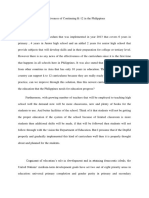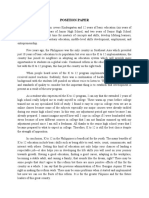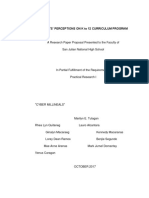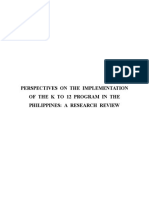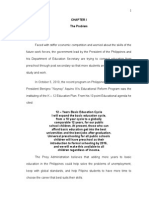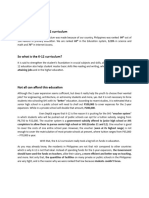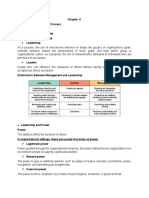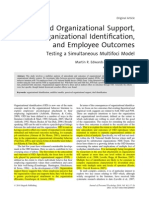For the past decades Philippines used the K-10 educaon for the educaon to teach children.However, last May 15, 2013, President Benigno Aquino ||| approved Republic Act (RA) 105333,signing into law which implement the K-12 program. K-12 program covers kindergarten and 12 yearsbasic educaon – six years of primary schooling, four years of junior high and addional two years of senior high. Provides mastery of skills for lifelong learners, prepare the students for careeropportunies and student’s global competency. Philippines is the last country in Asia and one of the only three countries in the world with a tenyears pre-university program. The implementaon of K-12 program in the Philippines is the key toour country’s development. Filipinos are known to be compeve in the internaonal community.The K-12 program helps them from becoming even more compeve and prepare graduates forterary educaon, middle-level skills development, employment, and entrepreneurship.Many Filipinos parents think that K-12 program is just a waste of me and money. Because of theaddional 2 years in the senior high before the terary educaon, the parents will invest moremoney for students because of K-12 program. No, it’s not a waste of me because K-12 programoers a decongested 12 year program that gives the students sucient me for them to masterstheir skills and absorb more basic competencies, that can use aer they graduate senior high to jointhe labor force of the country.According to Isagani Cruz (2010), The graduates of this program will be more prepared to enter thelabor force, high school graduates of the 10-years curriculum were not competent or well-equipenough for the workplace. In addion, high school graduates of the 10-years curriculum are not yet18. With the new curriculum, senior high school students can specialize in a eld that they are goodat and interested. As a result, upon graduaon they will have the specic job-related skills they needeven without a college degree. When they graduate from high school, these young people will be 18and employable, adding to the naon’s work force.The K-12 students can help their parents for daily expenses for their family aer they graduate fromthis curriculum, it is just their choice if they connue to go to college. Parents think that going tocollege is a problem because of tuion and other expenses. Yes, it is more expensive if unfortunatestudents will go to college when the students can get a job aer they graduate and can help theirparents. However, it is more advisable and has advantage in the the workplace if the students cangraduate a Bachelor’s degree and in studying, expenses and investments is unavoidable for thegreater good of their children in the future.According to Ma. Teresa Montemayor (2018), With the K-12 program, students are given beeropons and opportunies to improve their educaon and quality of life. To those who will go tocollege, the chances are all up to their hard work since the tuion is already free in state collegesand local universies.The educaon for college than the senior high is more expensive because of the tuion, projects,daily expenses, and the expenses for their thesis. Nevertheless, as a said earlier, it is unavoidable but
when the student and their parents join their hard work it is a great and sasfying for them and theirhard work will be pay o.The K-10 program has enough quality for the Filipinos to compete internaonally and it has a goodgoal which Filipino students achieve their dreams. Yes, many Filipinos have become successful intheir career in other country but that is just half of the story. Many in our OFWs are graduates of Bachelor’s degree in our country, but when they go to abroad to nd job they end up being just adomesc helper or caregiver because of the 2 years lack in the country’s educaon. They invest andstruggle to graduate a Bachelor’s degree but they just end up to do that job abroad and some of them are working hard to save up money so that they can study again while working and work fortheir chosen career in other country for high monthly salary. However, with K-12 program the wholestory will be dierent. According to Isagani Cruz (2010), Filipino graduates of K-12 program will be automacally recognizeas professionals abroad because we are following the internaonal educaon standard as praccedby all naons. There will be no need to study again and spend more money in order to qualify forinternaonal standards. With the K-12 program, Filipino professionals who aspire to work abroadwill not have a hard me geng jobs in their chosen eld. Furthermore, they will be able to helptheir families in the Philippines more with remiances, property purchase, and small businesses.Aer the implementaon of K-12 the quality of the educaon in the Philippines, become higher thanbefore. According to the ICEF Monitor, last 2013, in January 2013, the Philippine Bureau of Immigraon reported that of the 203,753 foreigners in the country, 47,478 are studying in schoolsand universies across the country (which 14% higher than the 41,443 foreigners who applied in2011). As the Bureau’s Commissioner Ricardo David Jr. said: “Our country is fast emerging as a neweducaonal hub in the Asia-Pacic region. More and more foreigners are coming here to study andit’s demonstrate recognion of the improved quality of our educaonal system.”According to ICEF Monitor (2014), reported that for internaonal students studying English inAustralia, the Philippines had entered the compeon as a desnaon opon for the rst me in2011.As the Programme Director of the Philippines ESL Tour Program Ruth Tizon said from an arcle in
The PIE News,
“the Philippines can compete with the US, UK or Australia as an ideal desnaon forstudying the English language. Aside from its large English-speaking populaon [93.5% of Filipinosspeak English well], competent schools and faculty, the Philippines has a rich cultural heritage, oersdiverse tourism aracons and acvies, and warmth and hospitality not found anywhere else inthe world.”
The implementaon of K-12 program the number of populaon will decrease and the dropout willincrease because the student’s do not have me to go in school and study because of the addional2 years in senior high. Yes, in the early implementaon of K-12, many of the Filipinos parents have adilemma if they will connue their children to go to senior high. The unfortunate ones, because of having a nancial problem they do not connue to study. But not now, public schools is now oeringa K-12 program, it is more ecient for those who can’t aord private school that oers K-12program. In addion, the government ocials oer and help the unfortunate students by givingthem scholarships.According to Philippine News Agency (PNA), Assistant Secretary Nepomuceno Malaluan, that asurvey in 2018 showed that Senior High School (SHS) educaon has decreased the percentage of dropouts among high school students. “Before, less than 50% of fourth year high school graduatesgo to college. Now, 93% of the SHS graduates will connue to college, this shows strong supportfrom learners.” he said.The K-12 is not a wasng me and money. It is very helpful to the Filipino students in the futurebecause of the benets that they will get. It will help not just the students but also the parents andespecially the country because of becoming one of the catalyst to improve our economy. Filipinoswill become more famous because of the quality of educaon and became one of the desnaonnot just in tourism and hospitality but also one of the desnaon to study. Moreover, because of theincreasing on our economy, we can help our fellow unfortunate Filipinos to improve the daily living;we can help the children to cross the mountain in ease to study, we can help other Filipinos to havetheir jobs, we can help the government and fellow Filipinos to improve everything in our country, toimprove each other so that we Filipinos may not perish in the future. We, in our generaon can change the future, we just need hard work, paence and help each otherto be on top. It may be crical as of now because of the country’s sll adjustments of this newcurriculum. Nevertheless, with the help and guide of the government ocials and our fellowFilipinos, we can pass this and the K-12 program will be very successful and bang its way to thefuture.
References
Abueva, N. (2019, September 5).
Why does the Philippines need the K-12 educaon system?
Retrieved from Soapboxie: hps://soapboxie.com/social-issues/The-implementaon-o-the-K-12-Program-in-the-Philippine-Basic-Educaon-CurriculumCalungsod, M. D. (2017, June 7).
A posion paper on K-12 program
. Retrieved fromhps://markrevin-wordpress-com.cdn.ampproject.org/v/s/markrevin.wordpress.com/2018/03/11/a-posion-paper-on-k-12-program/amp/?usqp=mq331AQNKAGYAYDZtu7LyNWsRw%3D%3D&_js_v=a2&_gsa=1#referrer=hps://www.google.comMontemayor, M. T. (2018, August 2).
K-12 implementaon must be connued afer review: Advocacy group
. Retrieved from Philippine News Agency: hps://www.pna.gov.ph/arcles/1043466Montemayor, M. T. (2018, June 5).
K-12 program to improve quality og educaon: Briones
. Retrievedfrom Philippine News Agency: hps://www.pna.gov.ph/arcles/1037617








